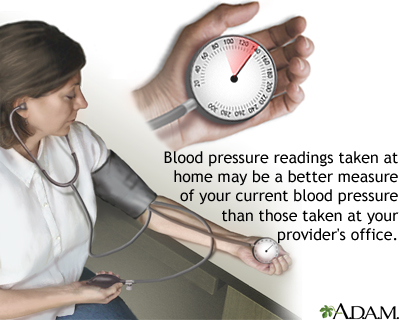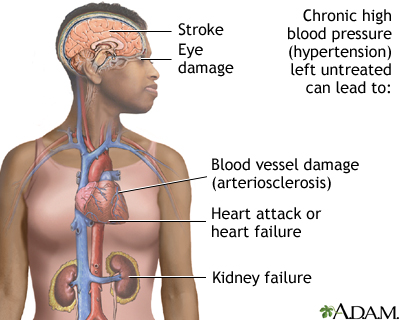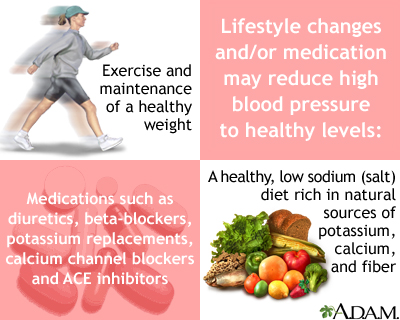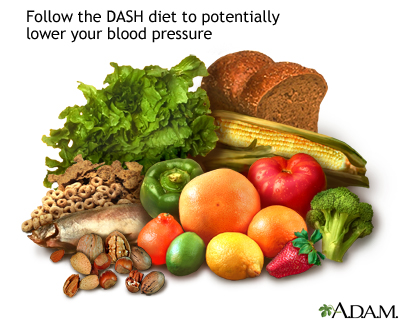Health Library
High blood pressure in adults - hypertension
Hypertension; HBP; High blood pressure
Blood pressure is a measurement of the force exerted against the walls of your arteries as your heart pumps blood to your body. Hypertension is the term used to describe high blood pressure.
Untreated high blood pressure can lead to many medical problems. These include heart disease, stroke, kidney failure, eye problems, and other health issues.
Blood pressure readings are given as two numbers. The top number is called systolic blood pressure. The bottom number is called diastolic blood pressure. For example, 120 over 80 (written as 120/80 mm Hg).
One or both of these numbers can be too high. (Note: These numbers apply to people who are not taking medicines for blood pressure and who are not ill.)
- Normal blood pressure is when your blood pressure is lower than 120/80 mm Hg most of the time.
- High blood pressure (hypertension) is when one or both of your blood pressure readings are higher than 130/80 mm Hg most of the time.
- If the top blood pressure number is between 120 and 130 mm Hg, and the bottom blood pressure number is less than 80 mm Hg, it is called elevated blood pressure.
If you have heart or kidney problems, or you had a stroke, your doctor may want your blood pressure to be even lower than that of people who do not have these conditions.
Images




I Would Like to Learn About:
Causes
Many factors can affect blood pressure, including:
- The amount of water and salt you have in your body
- The condition of your kidneys, nervous system, or blood vessels
- Your hormone levels
You are more likely to be told your blood pressure is too high as you get older. This is because your blood vessels become stiffer as you age. When that happens, your blood pressure goes up. High blood pressure increases your chance of having a stroke, heart attack, heart failure, kidney disease, or early death.
You have a higher risk of high blood pressure if you:
- Are African American
- Are obese
- Are often stressed or anxious
- Drink too much alcohol (more than 1 drink per day for women and more than 2 drinks per day for men)
- Eat too much salt
- Have a family history of high blood pressure
- Have diabetes
- Smoke
Most of the time, no cause of high blood pressure is found. This is called essential hypertension.
High blood pressure that is caused by another medical condition or medicine you are taking is called secondary hypertension. Secondary hypertension may be due to:
- Chronic kidney disease
- Disorders of the adrenal gland (such as pheochromocytoma or Cushing syndrome)
- Hyperparathyroidism
- Pregnancy or preeclampsia
- Medicines such as birth control pills, diet pills, some cold medicines, migraine medicines, corticosteroids, some antipsychotics, and certain medicines used to treat cancer
- Narrowed artery that supplies blood to the kidney (renal artery stenosis)
- Obstructive sleep apnea (OSA)
Symptoms
Most of the time, there are no symptoms. For most people, high blood pressure is found when they visit their health care provider or have it checked elsewhere.
Because there are no symptoms, people can develop heart disease and kidney problems without knowing they have high blood pressure.
Malignant hypertension is a dangerous form of very high blood pressure. Symptoms may include:
- Severe headache
- Nausea and vomiting
- Confusion
- Vision changes
- Nosebleeds
Exams and Tests
Diagnosing high blood pressure early can help prevent heart disease, stroke, eye problems, and chronic kidney disease.
Your provider will measure your blood pressure many times before diagnosing you with high blood pressure. It is normal for your blood pressure to be different based on the time of day.
All adults over the age of 18 should have their blood pressure checked every year. More frequent measurements may be needed for those with a history of high blood pressure readings or those with risk factors for high blood pressure.
Blood pressure readings taken at home may be a better measure of your current blood pressure than those taken at your provider's office.
- Make sure you get a good quality, well-fitting home blood pressure monitor. It should have a properly sized cuff and a digital readout.
- Practice with your provider to make sure you are taking your blood pressure correctly.
- You should be relaxed and seated for several minutes prior to taking a reading.
- Bring your home monitor to your appointments so your provider can make sure it is working correctly.
Your provider will do a physical exam to look for signs of heart disease, damage to the eyes, and other changes in your body.
Tests may also be done to look for:
- High cholesterol level
- Heart disease, using tests such as an echocardiogram or electrocardiogram
- Kidney disease, using tests such as a basic metabolic panel and urinalysis or ultrasound of the kidneys
Treatment
The goal of treatment is to reduce your blood pressure so that you have a lower risk of health problems caused by high blood pressure. You and your provider should set a blood pressure goal for you.
Whenever thinking about the best treatment for high blood pressure, you and your provider must consider other factors such as:
- Your age
- The medicines you take
- Your risk of side effects from possible medications
- Other medical conditions you may have, such as a history of heart disease, stroke, kidney problems, or diabetes
If your blood pressure is between 120/80 and 130/80 mm Hg, you have elevated blood pressure.
- Your provider will recommend lifestyle changes to bring your blood pressure down to a normal range.
- Medicines are rarely used at this stage.
If your blood pressure is higher than 130/80, but lower than 140/90 mm Hg, you have Stage 1 high blood pressure. When thinking about the best treatment, you and your provider must consider:
- If you have no other diseases or risk factors, your provider may recommend lifestyle changes and repeat the measurements after a few months.
- If your blood pressure remains above 130/80, but lower than 140/90 mm Hg, your provider may recommend medicines to treat high blood pressure.
- If you have other diseases or risk factors, your provider may be more likely to start medicines at the same time as lifestyle changes.
If your blood pressure is higher than 140/90 mm Hg, you have Stage 2 high blood pressure. Your provider will most likely start you on medicines and recommend lifestyle changes.
Before making a final diagnosis of either elevated blood pressure or high blood pressure, your provider should ask you to have your blood pressure measured at home, at your pharmacy, or somewhere else besides their office or a hospital.
LIFESTYLE CHANGES
You can do many things to help control your blood pressure, including:
- Eat a heart-healthy diet, including potassium and fiber.
- Drink plenty of water.
- Get at least 40 minutes of moderate to vigorous aerobic exercise at least 3 to 4 days a week.
- If you smoke, quit.
- Limit how much alcohol you drink to 1 drink a day for women, and 2 a day for men or less and consider quitting entirely.
- Limit the amount of sodium (salt) you eat. Aim for less than 1,500 mg per day.
- Reduce stress. Try to avoid things that cause you stress, and try meditation or yoga to de-stress.
- Stay at a healthy body weight.
Your provider can help you find programs for losing weight, stopping smoking, and exercising.
You can also get a referral to a dietitian, who can help you plan a diet that is healthy for you.
How low your blood pressure should be and at what level you need to start treatment is individualized, based on your age and any medical problems you have.
MEDICINES FOR HYPERTENSION
Most of the time, your provider will try lifestyle changes first, and check your blood pressure two or more times. Medicines will likely be started if your blood pressure readings remain at or above these levels:
- Top number (systolic pressure) of 130 or more
- Bottom number (diastolic pressure) of 80 or more
If you have diabetes, heart problems, or a history of a stroke, medicines may be started at lower blood pressure reading. The most commonly used blood pressure targets for people with these medical problems are below 120 to 130/80 mm Hg.
There are many different medicines to treat high blood pressure.
- Often, a single blood pressure drug may not be enough to control your blood pressure, and you may need to take two or more drugs.
- It is very important that you take the medicines prescribed to you.
- If you have side effects, your doctor can substitute a different medicine.
Outlook (Prognosis)
Most of the time, high blood pressure can be controlled with medicine and lifestyle changes.
When blood pressure is not well-controlled, you are at risk for:
- Bleeding from the aorta, the large blood vessel that supplies blood to the abdomen, pelvis, and legs
- Chronic kidney disease
- Heart attack and heart failure
- Poor blood supply to the legs
- Problems with your vision
- Stroke
When to Contact a Medical Professional
If you have high blood pressure, you will have regular checkups with your provider.
Even if you have not been diagnosed with high blood pressure, it is important to have your blood pressure checked during your regular check-up, especially if someone in your family has or had high blood pressure.
Contact your provider right away if home monitoring shows that your blood pressure is still high.
Prevention
Most people can prevent high blood pressure from occurring by following lifestyle changes designed to bring blood pressure down.
Related Information
Cushing syndromeGlomerulonephritis
Renal vein thrombosis
Acute kidney failure
Hemolytic-uremic syndrome
IgA vasculitis - Henoch-Schonlein purpura
Polyarteritis nodosa
Radiation enteritis
Retroperitoneal fibrosis
Wilms tumor
Hypertensive heart disease
Heart attack
Heart failure
Atherosclerosis
Aortic dissection
Injury - kidney and ureter
Stroke
Blindness and vision loss
Ventricular assist device
Obesity
Type 2 diabetes - what to ask your doctor
Heart failure - what to ask your doctor
High blood pressure - what to ask your doctor
Kidney removal - discharge
Diabetes eye care
Diabetes - preventing heart attack and stroke
Diabetes - taking care of your feet
Diabetes tests and checkups
ACE inhibitors
Heart attack - discharge
Angioplasty and stent - heart - discharge
Aspirin and heart disease
Butter, margarine, and cooking oils
Cholesterol and lifestyle
Antiplatelet drugs - P2Y12 inhibitors
Controlling your high blood pressure
Dietary fats explained
Fast food tips
Heart disease - risk factors
How to read food labels
Implantable cardioverter defibrillator - discharge
Low-salt diet
Mediterranean diet
Heart failure - fluids and diuretics
Heart failure - home monitoring
Heart failure - discharge
References
American Diabetes Association. 10. Cardiovascular Disease and Risk Management: Standards of Medical Care in Diabetes-2021. Diabetes Care. 2021; 44(Suppl 1):S125-S150. PMID: 33298421 pubmed.ncbi.nlm.nih.gov/33298421/.
Arnett DK, Blumenthal RS, Albert MA, et al. 2019 ACC/AHA guideline on the primary prevention of cardiovascular disease: a report of the American College of Cardiology/American Heart Association Task Force on Clinical Practice Guidelines. Circulation. 2019;140(11);e596-e646. PMID: 30879355 pubmed.ncbi.nlm.nih.gov/30879355/.
Bakris GL, Sorrentino MJ. Systemic hypertension: mechanisms, diagnosis and treatment. In: Libby P, Bonow RO, Mann DL, Tomaselli GF, Bhatt DL, Solomon SD, eds. Braunwald's Heart Disease: A Textbook of Cardiovascular Medicine. 12th ed. Philadelphia, PA: Elsevier; 2022:chap 26.
Weber MA, Schiffrin EL, White WB, et al. Clinical practice guidelines for the management of hypertension in the community: a statement by the American Society of Hypertension and the International Society of Hypertension. J Clin Hypertens (Greenwich). 2014;16(1):14-26. PMID: 24341872 pubmed.ncbi.nlm.nih.gov/24341872/.
Whelton PK, Carey RM, Aronow WS, et al. 2017 ACC/AHA/AAPA/ABC/ACPM/AGS/APhA/ASH/ASPC/NMA/PCNA guideline for the prevention, detection, evaluation, and management of high blood pressure in adults: a report of the American College of Cardiology/American Heart Association Task Force on Clinical Practice Guidelines. Hypertension. 2018;71(6):1269-1324. PMID: 29133354. pubmed.ncbi.nlm.nih.gov/29133354/.
Xie X, Atkins E, Lv J, et al. Effects of intensive blood pressure lowering on cardiovascular and renal outcomes: updated systematic review and meta-analysis. Lancet. 2016;387(10017):435-443. PMID: 26559744 pubmed.ncbi.nlm.nih.gov/26559744/.
BACK TO TOPReview Date: 2/23/2022
Reviewed By: Thomas S. Metkus, MD, Assistant Professor of Medicine and Surgery, Johns Hopkins University School of Medicine, Baltimore, MD. Also reviewed by David Zieve, MD, MHA, Medical Director, Brenda Conaway, Editorial Director, and the A.D.A.M. Editorial team.
 | A.D.A.M., Inc. is accredited by URAC, for Health Content Provider (www.urac.org). URAC's accreditation program is an independent audit to verify that A.D.A.M. follows rigorous standards of quality and accountability. A.D.A.M. is among the first to achieve this important distinction for online health information and services. Learn more about A.D.A.M.'s editorial policy, editorial process and privacy policy. A.D.A.M. is also a founding member of Hi-Ethics. This site complies with the HONcode standard for trustworthy health information: verify here. |
The information provided herein should not be used during any medical emergency or for the diagnosis or treatment of any medical condition. A licensed medical professional should be consulted for diagnosis and treatment of any and all medical conditions. Links to other sites are provided for information only -- they do not constitute endorsements of those other sites. © 1997- 2022 A.D.A.M., a business unit of Ebix, Inc. Any duplication or distribution of the information contained herein is strictly prohibited.
